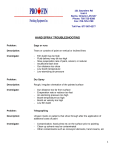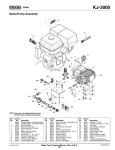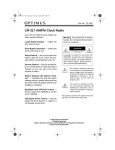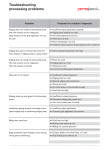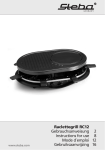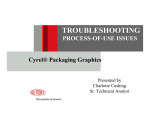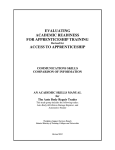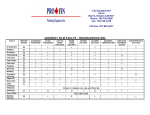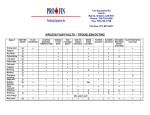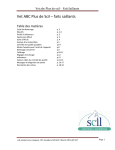Transcript
131 Saunders Rd Unit 6 Barrie, Ontario L4N 9A7 Phone: 705-725-0388 Fax: 705-725-1759 Toll Fee: 877-587-6277 WATERBORNE TROUBLESHOOTING PROBLEM Sagging of Film Dry Spraying Hiding Blushing Gloss Orange Peel Mudcracking Cratering or Pinholing DESCRIPTION Excessive flow in paint during application. Sandpaper like look on the part due to flow problems. The ability of a paint to obscure the background over which it is applied. Whitening of the part as it is being sprayed. The degree to which a surface reflects light. CAUSE REMEDY 1. 2. 3. 1. 2. 1. 2. 3. Over-reduction of coating. Application of too heavy a coat. Excessive fluid flow from gun. Lack of flow. Evaporation rate too fast. Over reduction. Improper atomization. Low film thickness. 1. 2. 1. 2. 1. 2. 3. 4. Paint drying or flashing too fast. High temperature and humidity. Low gloss – overreducing. Low gloss – film thickness. High gloss – high film thickness. Spotty low gloss – overbaking. 1. Use inhibitor to slow paint down. 2. Decrease room temperature and humidity. 1. Increase spray viscosity – use less water. A pebbled or wavy effect on the surface of the paint. 1. Application of too thin a film not Intersecting cracks penetrate at least one coat in a dried paint. Occurs when the coating becomes rigid before all of the volatiles have left the coating. Defects on the paint surface – small holes in the film. 1. 2. 2. allowing proper flow. Too much film thickness due to high viscosity. Low temperature. High film thickness. 3. 1. 2. 1. 2. 3. 2. Silicon contamination. Spots of grease on surface. Drops of oil from equipment. Use more passes. 3. Decrease paint flow. 4. Regulate oven temperature and airflow. 1. 2. Apply heavier coat / increase air pressure to atomize paint. Decrease spray viscosity. 1. Raise the room temperature, paint temperature, 2. 1. 2. 3. Use less water to reduce –heavier viscosity. Use more passes to build film. Cut back flow rate on gun. Increase fluid flow on gun. Slow coating down with inhibitor. Increase spray viscosity – use less water. Adjust spray equipment. Increase film thickness with more passes. and part temperature. Waterborne cannot be applied below 60 F. Apply less film thickness. 1. Locate source of contamination and eliminate. 2. Clean surface of part thoroughly. 3. Clean spray equipment.
